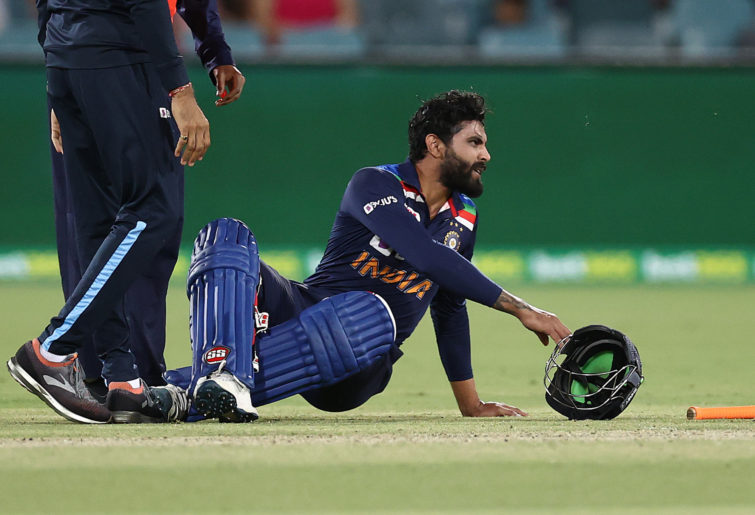Cricket’s concussion rule has to exist, but India have exposed its weaknesses as they claimed an emphatic 11-run victory over Australia on Friday night in Canberra during the first T20.
Now, let me clarify. I’m not a doctor. I have no medical knowledge surrounding whether Ravindra Jadeja was actually concussed or not when he was hit on the head during what was a powerful knock to propel India to a competitive total, which turned out to be more than enough.
But that simply isn’t the argument being made here.
The bottom line, from the evidence available, is that Jadeja never received an on-field concussion test. No doctor or physio came out to check whether he was okay to continue, which in this day and age of concussion protocols and sports taking a hard-line approach to players continuing on with such a potential injury was a surprise to say the least.
Of more concern to India and their fans was the leg injury Jadeja had picked up, reducing him to barely a hobble by the time he walked off Manuka Oval, not out with 44 from just 23 balls to his name.
In fact, the incident barely seemed worthy of a mention given the small amount of attention it received until Justin Langer and Aaron Finch were picked up in a heated discussion with match referee David Boon during the innings break.

Justin Langer fumed over India’s concussion sub. (Photo by Matt King – CA/Cricket Australia via Getty Images)
And just when the commentators were deliberating whether it was about Australia’s lousy over rate or not, out stepped Yuzvendra Chahal to field, with Jadeja nowhere to be seen.
Now, you could probably justify the replacement as being like-for-like, but the whole process and why it was allowed just smelt. Of course, India would have been allowed a sub fielder under conventional cricket rules for his injury, but it was deemed a concussion and so he sat in the dressing room as Chahal took a restrictive 3-25 from his four overs.
Chahal’s performance with the ball helped inspire India to push ahead in the series, which moves back to Sydney for the final two games on Sunday and Tuesday, but India have exposed a loophole in the concussion policy that the ICC need to urgently look at.
Again, Jadeja may well have been out with a concussion, but the fact no on-field test or reaction was carried out makes it smell like a rat, and sometimes, if it smells like that, well… you know, it is.
But this isn’t designed to make an excuse for Australia either.
They are yet to beat India in a T20 series at home, and based on Friday night’s effort, you’d be more surprised if that record turned around over the next week in Sydney than if it didn’t.
The match started out promisingly for the Aussies. Their bowlers did a decent job and then pushed well onto the front foot, only to let up at the death and have their batting collapse trying to get to what was a very manageable score.
There are plenty of areas the Aussies must improve, but after having India 5-104 off 16, there is no way they should have ended up with 161.
That is 57 from the final four overs. In other words, a completely unacceptable closing performance with the ball.
Ravindra Jadeja, who is among the best limited-overs players in the world, teed off with remarkable success all around Canberra. But Australia bowled the wrong areas, set a poor plan in an attempt to limit him and paid the price as a result.

Ravindra Jadeja’s concussion substitution sparked controversy in Canberra. (Photo by Ryan Pierse – CA/Cricket Australia via Getty Images)
What will make the loss even more frustrating for the Aussies is their score at the end of the power play: 0-53 off six overs, the required run rate falling and momentum with the green and gold.
It was a position they shouldn’t have lost from.
But there was still nagging doubt. D’Arcy Short failed to get going, and when Aaron Finch departed followed by a mini collapse as Steve Smith and Glenn Maxwell came and went shortly afterwards, things started to get out of hand.
Short was a key offender of the Australian chase, falling short as he eventually got himself out in the 15th over for 34 at less than a run a ball. Chasing eight an over, you simply can’t afford a batsman to bat under a strike rate of under 100 for that long. It builds pressure, and digs a hole for the batsmen around him.
It cost Australia momentum and rhythm in their innings, and by the time Chahal had finished his four overs to go with Washington Sundar’s 0-16 off four, it was all too little too late for the Aussies despite a late flurry from Moises Henriques, who was one of the hosts’ best.
Despite dropped catches from Virat Kohli and an Indian team still not at their best, the tourists had the better of the T20 opener in Canberra by a considerable length, no matter what the 11-run gap at the end seems to suggest.
While Australia still haven’t seemed to figure out playing T20 cricket (remember, they have only made one final in six editions of the World Cup), the ICC also haven’t fully figured out the concussion substitute.
With a pair of World Cups on the horizon and cricket picking back up again (although with South Africa’s ODI against England postponed due to a COVID case and the problems Pakistan are facing in New Zealand, who knows), both Australia in the shortest form of the game and the ICC have plenty to figure out.
For now though, it’s short-term objectives for Australia, and that has to be getting their selection right, overcoming the loss of David Warner and finding a way to bounce back in Game 2 on Sunday in Sydney.






























































































